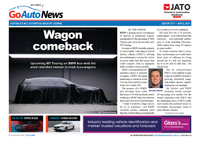 1 Oct 2006
1 Oct 2006
HOLDEN has a lot riding on the new Captiva 4WD wagon. This Australian-developed and Korean-sourced SUV takes over from where the poorly performing Adventra left off, adopting the "big wagon" style of the medium SUV brigade, with a tall body, upright high seating position and compact dimensions.
Four models are offered, sharing a 3.2-litre version of Holden’s Alloytec V6 combined with a five-speed automatic gearbox (with sequential-manual shift mode).
In the SX five-seater and CX and LX seven-seater models, the engine develops 169kW at 6600rpm and 297Nm at 3200rpm. The Maxx is 3kW down on power because it uses a different exhaust system.
Holden forecasts that around 80 per cent of Captiva buyers will choose the GM Daewoo-designed SX, CX and LX variants, with the rest drawn towards the range-topping Maxx, which is based on the European-designed Opel Antara.
The latter uses the same platform as the lower-series vehicles and both are built on the same production line in South Korea.
Nevertheless, Holden claims to have been heavily involved in the Captiva’s development for at least two years, honing the ride, handling and steering, and calibrating its traction and stability control systems specifically for the Australian market.
All Captiva models share the same 2707mm wheelbase and 1562mm front and 1572mm rear track, as well as interior legroom.
All have a four-link independent rear suspension with MacPherson struts up front.
Like many of the Japanese soft-roaders, the Captiva is a front-drive with a twin clutch system that delivers AWD when the system identifies the need for extra traction.
In early 2007 Holden released the Captiva Diesel, completing the model’s launch engine line-up.
Slated for the larger five and seven-seater models, the VM Motori/GM DAT co-op 2.0-litre four-cylinder common-rail turbo-diesel develops a healthy 110kW of power and 320Nm of torque.
Mated to a five-speed manual or automatic gearbox, this Euro IV compliant powerplant’s biggest drawcard is its modest price increase over the continuing 3.2-litre V6 petrol – only $1000, when rival diesel models often exceed $4000 for the privilege.
A 110kW/320Nm 2.0-litre four-cylinder turbo-diesel was added to the Captiva range in early 2007. It is offered in five-speed automatic or five-speed manual guise.



















